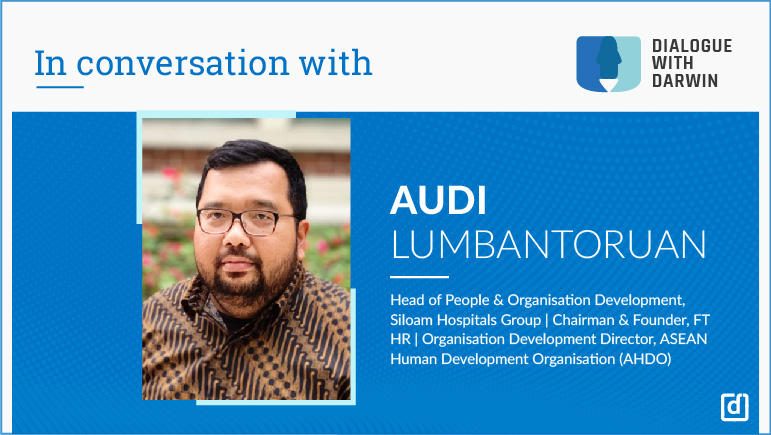 With Augustus Azariah Employee & Labor Relations Leader, Kyndryl
With Augustus Azariah Employee & Labor Relations Leader, Kyndryl
Focusing on the Now of Work
Listen to his insights on the ‘Future of Work,’ that much-debated topic – hybrid work, talent management and much more.
Transcript
His journey started in tech sales consulting and training around the same time when the IT industry was gaining roots in India, and then he's had two and a half decades of experience in HR functions. He holds numerous accolades as well as an honorary doctorate for his contribution to the HR function and has held various leadership roles within IBM India, HR.
Mentor to several startup founders and a staunch supporter of women's employability and stem education for the girl child. He also runs the past called the ‘looking above’ that brings this ideology to action. We are delighted to have you on the show. Augie, thank you so much for joining us today.
Truly delighted to be here Gowthami and I hope we have a very interesting and exciting conversation for our viewers. Yeah, looking forward to it. To begin the conversation with something that we know you've been a very active proponent and speaker about, wanted to begin by asking you, how do you view the future of work in the workforce is in a return-to-work mode?
Thank you. A very relevant question. So, first, we are what I would call is the ‘Now of Work’. Okay. And of course, we've been speaking about the future of work for a very long time, but it is the now of work. And with the now of work comes the new ways of work. So, the new ways of working also are accelerated by the working workforce shift during the pandemic.
Now, how does it look now? First look at the sentiment of employees on the return to the office. By and it's 50/ 50. Meaning 50% are in base locations and would like to come to work. And some of them are already coming into office campuses and working, or they're at client locations where clients do insist that they must be there, with all safety protocols in place, there is the other workforce that has largely the younger workforce, who migrated from other cities into their base locations and went back home during the pandemic due to various reasons because of the paying guest accommodations shut down that they were in, they were all joining together and renting out a place for shared accommodations.
And some of those folks are also engaged with eldercare or childcare and various such things. And the pandemic has taken its toll on various families. So, they need time. So, half of your workforce is ready to work albeit in a hybrid manner. The other workforce, we've got to give them time, we have got to be sensitive to their needs and some of them will have to come back and do a new home deal because people move lock, stock, and barrel. Some could have health issues. In terms of childcare, crushes are not yet open, very selectively they've opened. So, you have to consider all these aspects before getting the workforce in and look at certain exceptions.
For example, pregnant women or those who are the maternity, and then there could be others with comorbidities, who are unable to come work, then you allow them to figure out, Hey, what do I do? Do I need to look at other opportunities for this person? Okay. So, lots to think about here.
No, absolutely.
I think the broad understanding is that that have multiple people with different levels of comfort in terms of returning to work, right? You could briefly touch upon what does this mean for organizations to be prepared to welcome such a hybrid work, the workforce to the office?
I think welcome has been the often-repeated word here. Right? A lot of companies have done various activities to welcome employees, but to be very honest with you, did it get the desired result? The answer is no. People didn't come back to the office in goats. Okay. So, it was a very welcoming, strategy that management, HR, and that was the right thing to do.
But there has been some resistance of course, for people to come and therefore clear policy is required to be defined. Okay. Once you've defined it, I think you need to run enablement for managers and supervisors so that they engage with their people more effectively in terms of what does this hybrid work policy would have?
Would you be working 30%, 50%, whether you'd be going, what are? You know, and, and things like that, you know, will you even have your own workstation? You're going to have a revolving or repeating workstation. And therefore, what about my safety? Because somebody else was using my workstation some time ago, you know, there are various such questions in people's minds.
That limits their ability to take that step to come. But I don't think there is a huge resistance as such. I suppose people really want to come. They want to meet friends. They want to be with colleagues. They want to collaborate, they want to have those water-cooler moments and communication is key here.
So, the organization needs to communicate that return to office policy in a very clear and lucid manner. Highlight. Security concerns, safety, and above all, any other considerations that people might have.
It is more to make sure that people feel safe about coming back and people feel completely informed about what it means to come back.
Moving on. And other space that you have actively educated about and is also going through a transformation, given the changes around, how do you think organizations have been renting talent management and talent development in current times
It is a bit of an unrelated answer. We are in a gig economy; we have a gig workforce. It's about talent management and talent development teams looking at this workforce very clearly. And they are here to stay. So first, you have different types of workforces. You must ensure it's like a menu card or this it's like a recipe, right. You must put so much of all these things to get the right, what I would call the right workforce mix. Once you have the right workforce mix, you decide what temperature you want to put on the oven and get what you want out of it. So, talent development and talent management folks need to be very adaptable and open to what the business needs.
And to a large extent do businesses need as many regulars, like as many contractors, as many gig workers, like many consultants, as many part-timers do I have the right part-timers work policy, you know, can I mix in mind that flexibility needs to be there so that our business can be scalable. And especially as we continue to be volatile, the volatility was not just the pandemic. Today there is a war. There is an economic meltdown here. So, we must have very clear flexible, scalable talent development and management.
Absolutely. I really liked when you said, it's not the future, but it's the now of work. I think that can be good. How constant change is going to be, and I think the response is required at the same pace. So that's fantastic to learn.
For the last one that, this is going a step deep into the talent management aspect, specifically, the performance management space. How do you think that would be shaping up given the composition of the workforce becoming more gig, or hybrid, even multi-generational like you mentioned?
In terms of performance management space, I think it's a process of continuous improvement. And, uh, while organizations have their own challenges in my mind. So, while you're driving a high-performance culture, you should also focus on how you're going to be managing low performers or those who are trending to plateau. Because in some cases, you know, there is technology redundancy. And there are, in some cases, you know, carrier velocity has slowed down, or right now, you would do reskilling upskilling and things like that.
But wherever you don't get the desired results, I think organizations should have a very clear focus on managing performance. Okay and if they don't make the cut and look at other opportunities and options for them only then will you be able to drive a high performing.
I've been no brings me to think of an old saying, the slowest person decides the total speed of the team that is moving forward. Then it's about also improving the performance of that individual as well. Interesting insights all over a lot of learnings for us to take away in terms of how to prepare ourselves for the hybrid work culture that is going to happen.
And for a technology-backed future of work.
Now, thank you so much for offering those insights.
SEG 2:
Moving on to a segment where we want to bring more about you. And on a lighter note, more of quick, rapid-fire questions, that we would like to ask you.
Let me start with a book recommendation that you would have for our audience. That should be Lynda Gratton's ‘future of work’.
We've gone through many moments of uncertainty and fear in the past two years. Any advice to the listeners on how to navigate through uncertainties in work orders?
I think you have to adapt. We adapted well, and we have to sustain that behavior of adaptability. Needless to say, prioritize, we got to prioritize work and person, because like I told you, it is no more work-life balance. It is the work-life integration, the office came from but don't make your home officious, maintain that. But at the same time, drive workforce integration, and work-life integration. It's not easy. It's a journey.
What is that one motto that you live by?
The one motto that I live by is that whatever I get out of myself, I should be sensitive about it for other people. Also, I can't be driving certain people so much more than I cannot drive myself. So, in a small word, it's empathy. All right. So, somebody has a particular situation or issue. I would handle that with empathy.
Just like I will put myself in that person's shoes and do it that way. So, empathy is the one key that I believe is important and that I follow, believe, and I applied in my life.
So the last one, any tips to make work exciting in the home office setup?
So, plenty of them, one is you've got to embrace them. A lot of companies have done it, you know, to even send a cake to the entire family, a box of nuts and things like that, because now you know that it's just not this employee, but look, he's also been infringing on your space. So, organizations have realized that, and I suppose one important practice there is embracing the family and therefore making it more inclusive and creating an ecosystem that fosters that sense of collaboration and encouragement, that helps to innovate things.
Nominate Myself
Nominate Someone Else
Your Sunday Watchlist
 With Rajneesh Malik
With Rajneesh Malik
Global Head- Talent Management & Talent Acquisition, MindTickle
In this interview, he talks about various aspects of organizational culture, hiring, his views on the importance of putting people at the heart of the business, and much more.
 With Chitbhanu Nagri
With Chitbhanu Nagri
Sr VP of People Operations at Razorpay
Listen to his insights on organizational culture, talent retention, and some learnings from his current role at Razorpay.
 With Priya Chakravarty
With Priya Chakravarty
Sr Director HR in Essar Capital
Listen to her insights on managing a distributed and diverse workforce in the hybrid work setup, and some interesting HR initiatives at Essar Capital.
 With TN Hari
With TN Hari
Author, Angel Investor, CHRO, Big Basket
Listen to his insights on building a sustainable company culture in the hybrid world.






